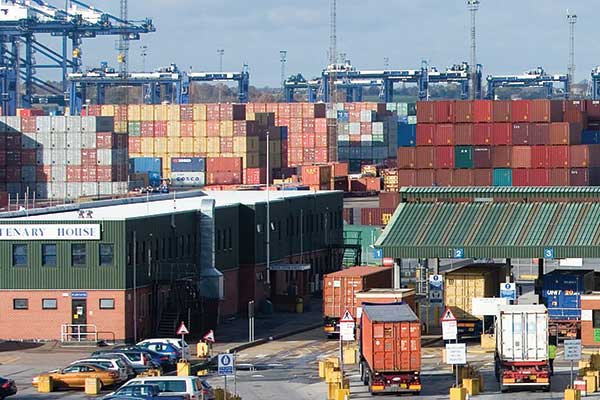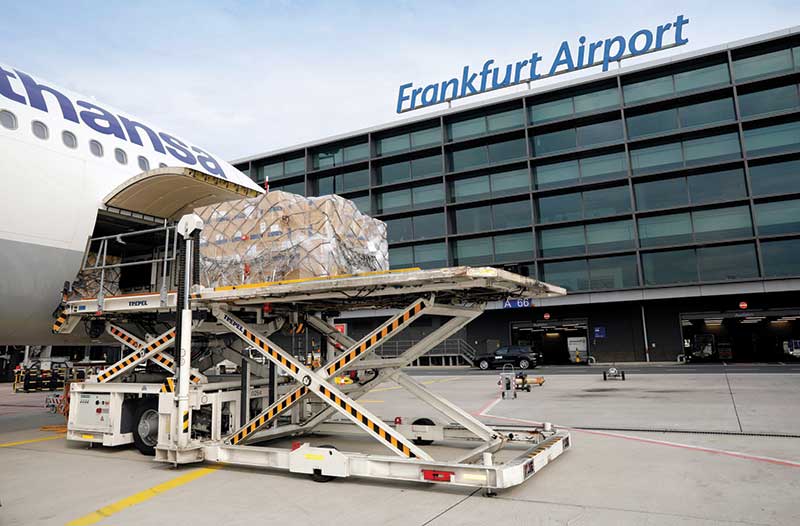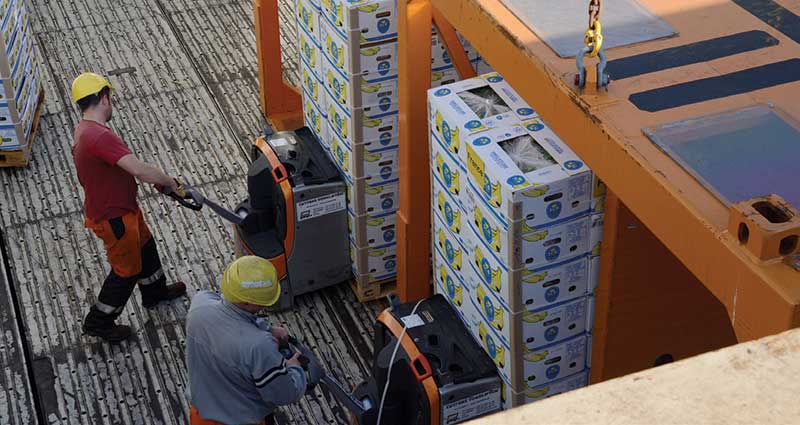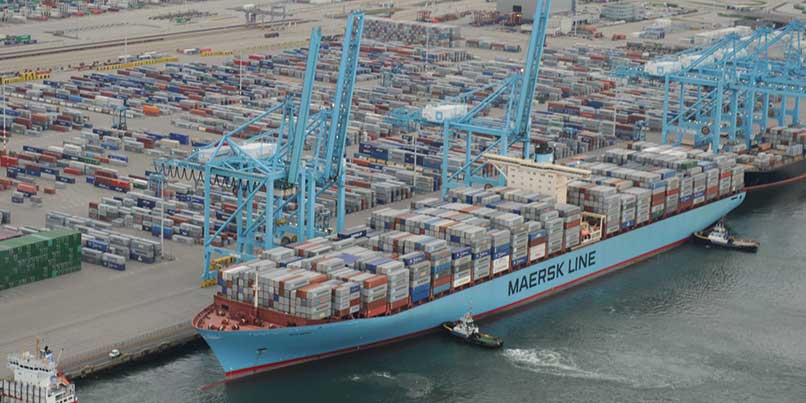EU Update 2024: Crises lead to growth
In light of the current political and economic developments, the mood in the European transport and logistics branch remains somewhat subdued. However, the crises have taught the logistics industry the importance of resilient supply chains—and thus the need for diversification of logistics services.

The year 2023 was filled with challenges, and 2024 is unlikely to be any easier.
In fact, the laundry list of issues is simply not going away. Geopolitical tensions, the ongoing war in Ukraine, low growth rates in many European countries combined with high inflation and energy costs, falling consumer demand, and slumps in key industries have all led to production relocations and thus new requirements and changes in how global supply chains operate.
In addition, new EU directives on decarbonization and new border controls after Brexit are challenges for the transport and logistics industry and are causing a lot of discussion.
The crises have taught the logistics industry the importance of resilient supply chains, and thus a diversification of logistics services. As a result, competitors in Europe are becoming partners who join forces in strategic alliances and European carriers are expanding their portfolios through company acquisitions to become full-service logistics providers.
New collaborations and acquisitions
One example of such a transformation is CMA CGM. In 2023, the French CMA CGM Group pursued its strategy of developing an integrated suite of logistics solutions to support its customers’ supply chains.
Following the acquisition of CEVA Logistics in 2019 and Ingram Micro CLS, Colis Privé, and GEFCO in 2022, CMA CGM continued its transformation in 2023 with an agreement to take over the French company Bolloré Logistics. The acquisition was approved by the EU Commission at the end of February this year, subject to conditions under the EU Merger Regulation.
Once the takeover of Bolloré Logistics has been completed, CMA CGM says it will become one of the world’s five largest transport and logistics service providers. In January 2024, the CMA CGM subsidiary CEVA Logistics made a bid for the UK logistics service provider Wincanton.
The aim is to continue to grow in the food and consumer goods logistics sectors of the UK and Irish markets. However, it looks like the company will have to enter a bidding war, as an offer from U.S.-based GXO Logistics was also thrown into the ring at the end of February.
CMA CGM also plans to continue expanding its airfreight business over the year. The company now operates a fleet of five aircraft, which will be strengthened in 2024 with the delivery of two Boeing 777F freighters. However, the collaboration between CMA-CGM Air Cargo and Air France-KLM Cargo, which began in April 2023 and was planned for 10 years, was terminated without giving reasons.
In its financial report for 2023, the CMA CGM reported an overall year’s revenue of $47 billion, reflecting a decline of 36.9% from the prior year, attributed to the deteriorating conditions in maritime shipping markets.
MAERSK and Hapag-Lloyd also announced a new cooperation in the shipping industry in mid-January. Under the name “Gemini Cooperation,” the two carriers intend to create a joint service network beginning in February 2025. The new cooperation will comprise a fleet pool of around 290 ships with a combined capacity of 3.4 million standard TEUs. MAERSK will provide 60% of this capacity and Hapag-Lloyd 40%.
As part of the agreement, the two companies have set themselves the ambitious goal of achieving a schedule reliability of more than 90% once the network is fully implemented. According to information provided by the two carriers, the realignment of future route planning in particular should contribute to this. The two cooperation partners intend to manage their global scheduled services mainly via central transshipment hubs. A total of 12 container ports are to be included in this hub planning.
When selecting terminals and ports, it can be assumed that primarily locations with existing holdings will be chosen. This realignment will also affect the European ports and container terminals. Further changes are also to be expected for the two carriers’ existing alliance partners as a result of the new cooperation.
With the end of “THE Alliance,” which runs until January 2025, the question of new collaborations will have to be decided for the existing Hapag-Lloyd partners ONE Ocean Network Express, Yang Ming, and HMM Hyundai Merchant Marine. The current “2M Alliance” between MAERSK and MSC will also expire at the end of January 2025.
Europe also continues to be an important growth market for American logistics providers. The Chicago-based AIT Worldwide Logistics, for example, has strengthened its presence on the European market with three company acquisitions in the past four months. The focus was on companies specializing on time-critical transports in the pharmaceutical, high-tech, and energy sectors.
In December last year, AIT Worldwide already acquired Mach II Shipping Ltd, a U.K.-based freight forwarder specializing in worldwide distribution of pharmaceuticals and related products. This was followed by the acquisition of Global Transport Solutions (GTS) in February 2024, a Dutch freight forwarding company specialized in shipping spare parts for the shipbuilding industry.
Another acquisition by AIT was the Dutch Lubbers Logistics Group, which was announced in November last year and completed in February of this year. The acquisition serves as a significant milestone for AIT, as the company continues to expand its global reach and enhance its offerings in road transportation, freight forwarding, and project logistics, particularly in the energy sector.

“This deal enhances our position in Europe and bolsters our presence in the energy sector, allowing us to better serve current customers while creating new opportunities,” says AIT’s chairman and CEO Vaughn Moore. AIT will now have market access to three to new countries: Denmark; Romania; and Turkey. Lubbers also has facilities in Germany, Italy, Norway, and the UK. With the three acquisitions, AIT’s European footprint of more than 45 offices will now stretch across 13 countries, making it the company’s second-largest region after North America.
European seaports and airports under pressure
Geopolitical tensions, inflation, and low economic growth are not stopping at Europe’s largest seaports.
Port of Rotterdam’s container throughput totaled 13.4 million TEUs in 2023, a decrease of 7% compared to 2022. The port cites lower consumption and production in Europe, and the loss of volumes to and from Russia due to the ongoing sanctions against the country, as main reasons for this development. Other North Range ports also saw declining rates.
Port of Antwerp-Bruges reported a decrease of 7.2% to 12.5 million TEUs. In contrast, its market share in the Hamburg-Le Havre range rose by 0.6% to 30.2% in 2023. Container throughput at the Port of Hamburg went down by 6.9% to 7.7 million TEUs. Traffic with the United States continued its ongoing positive development from
the previous years.
Hamburg handled a total of 653,000 TEUs in 2023, and the United States has become the ports second largest trading partner. The French ports Le Havre/Rouen/Paris (HAROPA) reached 2.63 million TEUs in 2023, a 15% decrease mainly due to weaker transshipments.
Last year was also a difficult year for Europe’s air cargo industry, as falling market demand and tariffs reduced revenues and forced many carriers to reduce their operations and cut their budgets. According to the International Air Transport Association (IATA), European carriers posted a 3.9% decrease in demand in 2023 compared to 2022 (-4.1% for international operations).
During the same period, airlines saw capacity increase by 4.5% for both global and international operations. European airports were also under pressure. Airports Council International (ACI) Europe reported that freight traffic across the European airport network declined by 2.1% in 2023 compared to the previous year, as a direct result of geopolitical and trade tensions and supply chain disruptions.
Intro of new Brexit controls
With Brexit, the UK’s departure from the European Union meant that UK exporters were immediately subject to the full range of controls when entering the EU. However, the UK government has repeatedly delayed imposing controls in the other direction—until this year.
Around four years after leaving the EU Customs union and single market, the UK is beginning to control food imports from the EU, presenting new challenges for EU exporters and their logistics providers. In 2024, the UK is gradually introducing its new Border Target Operating Model (BTOM) in three stages, which means additional customs rules, physical checks, and thus more paperwork when exporting goods to the UK.
As of January 31, 2024, all live animals, animal products, animal by-products, plants, and plant products will be classified into three different risk categories, which are low, medium, and high. The risk categorization will determine what documents are required to import the goods.

The first step of the BTOM implementation phase includes the introduction of health certification on imports of medium-risk animal products, plants, plant products, and high-risk food and feed of non-animal origin from the EU.
Stage two will start on April 30, 2024, with the introduction of documentary and risk-based identity and physical checks on medium-risk animal products, plants, plant products, and high-risk food and feed of non-animal origin from the EU.
Physical checks based on the risk category will be introduced at designated border control posts (BCP), which are located for example at UK ports and airports. The final stage of BTOM will take effect from October 31, when the safety and security declarations and control for EU imports come into force. From this date, a declaration to UK customs will apply to all import shipments from the EU.
Logistics UK’s head of trade, Nichola Mallon, complained that there is still great confusion on the border checks after the introduction of the first stage of BTOM and is calling for clarification from the government. Jill Rutter, senior fellow from the think tank Institute for Government, also warned that inflation in the UK could rise again in the British election year 2024 due to the new controls and the expected longer delivery times.
The problems could become even greater if EU companies were to stop doing business in the UK due to rising costs and higher expenses, explained Rutter. This could lead to shortages and supply disruptions for goods as diverse as pork, tulips, and strawberries.
New regulations for the shipping industry
The assimilated Liner Shipping Consortia Block Exemption Regulation (CBER), which sets out an automatic exemption for certain agreements between liner shipping companies, will expire in the EU on April 25, 2024. The CBER covers certain types of cooperation to provide joint services through “consortia.”
In line with the European Commission, the UK’s Competition and Markets Authority (CMA) will not recommend to the secretary of state for business and trade that the current CBER will be replaced by an equivalent UK national regulation. Based on its analysis, CMA already concluded in November 2023 that conditions did not justify the continued existence of a CBER for UK maritime movements. Thus, it is in agreement with the European Commission’s view. Both parties are no longer convinced that the efficiency gains achieved through shipping privileges in maritime transport justify the restrictions on competition.
The British International Freight Association (BIFA) welcomed this decision. In the recent past, the UK’s main trade association for freight forwarding and logistics companies has said that its members are extremely concerned that practices undertaken by container shipping lines, as well as easements and exemptions provided to them, have been distorting the operations of the free market to the detriment of international trade.
Steve Parker, BIFA’s director general says: “The decision confirms the provisional recommendation made by the CMA in November 2023 and is a sensible conclusion to the ongoing container market public consultation that has been conducted by the CMA since the start of last year. BIFA and its members are not anti-shipping line. The association wants to ensure that there is a suitable balance between them as carriers, and our members as customers, points made during various meetings with the CMA.”

In 2024, there are also new EU-regulations coming into force to support decarbonization. On January 1, 2024, the European Union Emissions Trading System (EU ETS) was extended to the maritime sector to cover CO2 emissions from all large ships (of 5000 gross tonnage and above) entering EU ports, regardless of the flag they fly.
Ship owners and shipping companies will be subject to an emissions cap, with allowances auctioned within the ETS and with other markets to encourage reductions across applicable sectors. The system covers 100% of emissions from intra-EU voyages, and 50% of emissions from extra-EU voyages, with special rules to prevent evasion.
The EU ETS covers CO2 (carbon dioxide), CH4 (methane), and N2O (nitrous oxide) emissions, but the latter two only from 2026 on. A transition phase is planned for the years 2024 and 2025, during which the proportion of emissions for which emission allowances must be surrendered will gradually increase from 40% in 2024 to 70% in 2025 and 100% in 2026.
In the end
In view of the current political and economic developments, the mood in the European transport and logistics branch is subdued. The next U.S. presidential election is one source of worries. U.S. tariffs on imports from Europe, and further trade restrictions, as threatened by former President Trump, would put considerable burdens on transatlantic trade relations and the supply chains. And the worldwide situation is already under strain from conflicts, disruptions, and economic uncertainty.

Article Topics
AIT Worldwide Logistics News & Resources
EU Update 2024: Crises lead to growth AIT Worldwide Logistics opens up new L.A.-based West Coast headquartersLatest in Logistics
GXO’s acquisition of Wincanton is a done deal Q1 sees a solid finish with strong U.S.-bound import growth, reports S&P Global Market Intelligence Understanding the FTC’s ban on noncompetes UPS rolls out fuel surcharge increases U.S. rail carload and intermodal volumes, for week of April 20, are mixed, reports AAR Baltimore suing ship that crashed into bridge, closing port, costing jobs Intermodal growth volume remains intact in March, reports IANA More LogisticsSubscribe to Logistics Management Magazine

Find out what the world's most innovative companies are doing to improve productivity in their plants and distribution centers.
Start your FREE subscription today.
April 2023 Logistics Management

Latest Resources














